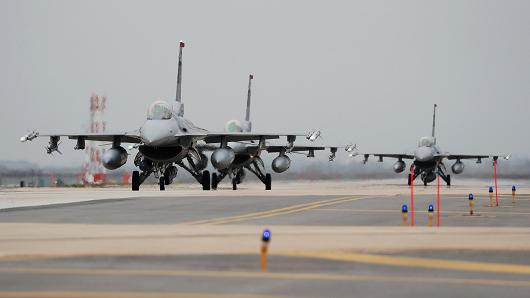
SeongJoon Cho | Bloomberg | Getty Images
U.S. Air Force F-16 Fighting Falcon fighter jets, manufactured by Lockheed Martin Corp., taxi on the tarmac during the Max Thunder Air Exercise, a bilateral training exercise between the South Korean and U.S. Air Force, at a U.S. air base in Gunsan, South Korea, on Thursday, April 20, 2017.
The U.S. Air Force needs stable budgets and is too small for all the missions it’s being asked to carry out, Air Force officials told reporters Thursday.
“The fiscal 2018 continuing resolution is actually delaying our efforts to increase the readiness of the force, and risk accumulates over time,” said Air Force Secretary Heather Wilson. “We are stretching the force to the limit, and we need to start turning the corner on readiness.”
The Air Force flew over 14,000 sorties in the last three months alone: It’s tasked with supporting not only operations in the Middle East and Afghanistan and Europe, but also the pressure campaign against North Korea and hurricane relief efforts, among other missions, according to Air Force Chief of Staff Gen. David Goldfein. Also, he said the Air Force plans to have “a continuous bomber presence” in Guam or the nearby region in response to the threat from nuclear-armed North Korea.
Wilson recalled meeting a pilot last week who just came back from his 17th deployment. “They’re carrying a heavy burden,” she said. We’re burning out our people because we’re too small for what the nation is asking.”
Appearing at a Pentagon press conference, both officials called for an end to sequestration, or the automatic federal spending cuts mandated under the 2011 Budget Control Act. They said the sequestration has negatively impacted the force in many ways, including in retaining experienced pilots.
“Our biggest need right now is for a higher and stable budget to provide security and solvency for the nation,” said Wilson.
The current short-term continuing resolution funding the Pentagon is set to expire Dec. 8. In recent years, Congress has relied on continuing resolutions or so-called omnibus measures to keep the U.S. government operating.
“Our high operations tempo over 26 years of combat have taken its toll and budget instability is not helping,” said Goldfein. “So you understand why Secretary Wilson and I remain adamant that Congress turn off the auto pilot and get back in control of the budget. We must find a way to lift sequestration as it is currently structured.”
Wilson also provided figures showing the Air Force’s pilot shortage has deepened.
According to Wilson, the Air Force has a deficit of about 2,000 pilots out of a total force of about 20,000 aviators. “That’s one in 10 that we’re short,” she said, pointing out that last summer the pilot shortfall was only about 1,500 pilot.
“If we go through sequester again, a 2,000 pilot shortage will be a dream,” said Wilson. “People will walk.”
The pilot shortage is a national problem that also has been felt in commercial and business aviation, and private industry has been known to offer generous compensation to attract seasoned military aviators. In response, Congress has given the Air Force authority to offer aviation bonuses to pilots who extend their service.
Goldfein said it takes an average of 10 years to raise a fighter pilot and about $10 million. “You’re 1,000 short, that’s $10 billion of capital investment that just walked out the door. So we’re first and foremost looking to retain everyone we can.”
At the same time, Goldfein said, the Air Force is preparing to accelerate its flight training efforts. He said the force plans to increase the number of pilots earning wings annually, from about 1,200 at present to some 1,400 pilots. Also, more focus will be put on increasing the number of fighter pilots.
 EU News Digest Latest News & Updates
EU News Digest Latest News & Updates



